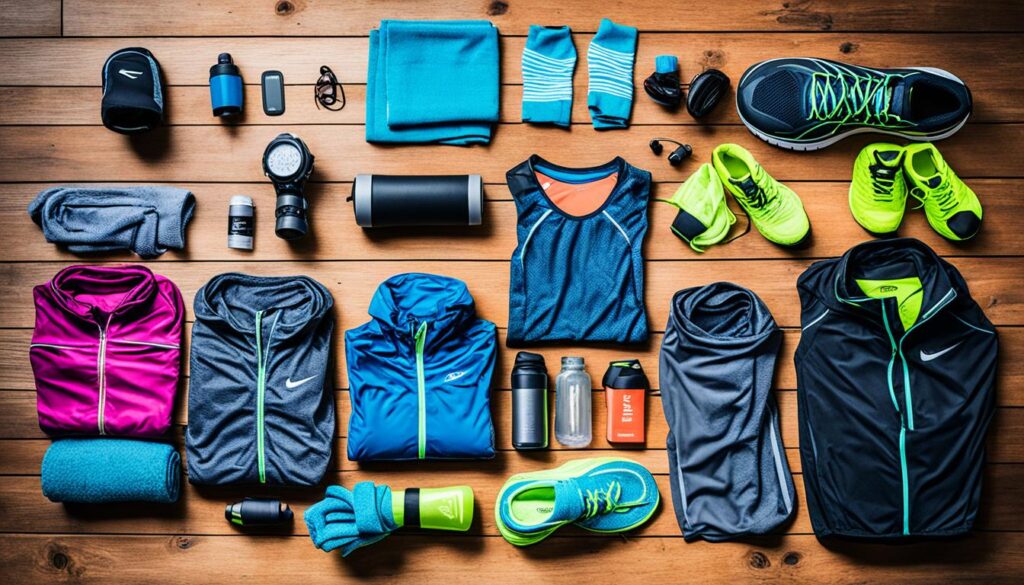In the United States, 60 million people enjoy running regularly. This shows how much people love running. Maybe you’re thinking about starting to run. You’re not alone. People run for many reasons like feeling good, getting healthier, or enjoying the outdoors. This guide will show you how. It offers tips from experts for beginners. You will learn how to go from walking to running confidently.
Key Takeaways
- Discover the basics of how to start running, setting you on a path toward lasting health benefits.
- Utilize beginner running tips to create a personalized and sustainable running routine.
- Gain insight on how running for fitness is not just a physical pursuit but a holistic one, boosting mental and emotional well-being.
- Learn from the expertise of seasoned coaches on how to build endurance and integrate running into your daily regimen.
- Understand the importance of a structured training program, tailored to your own pace and ability.
The Inspiration to Begin Running
For many, watching marathons brings an intense running motivation. This energy becomes the spark for taking the first running steps. Deciding to run for weight loss and health means taking that vital first step outside in your sneakers.
Starting a new habit can seem tough. Charles Duhigg’s idea can help. He talks about cue, routine, and reward to develop habits. Imagine having an alarm as a cue to run, then enjoying the run, and finally rewarding yourself with something nice, like a smoothie.
“The golden rule of habit change: You can’t extinguish a bad habit, you can only change it.” – Charles Duhigg
It’s crucial to set realistic goals when running for weight loss. Celebrate every run as a step towards better health. It’s the mental challenges that can be the hardest to overcome. Remember, running motivation is about improving your health and happiness.
Consistently running makes it part of who you are. It’s about overcoming laziness and enjoying moments of freedom while running. Soon, you’ll look forward to these times of personal victory.
- Start Small: Begin with short, manageable distances that feel comfortable.
- Consistency is Key: Run regularly to turn action into habit.
- Rewards Matter: Treat yourself after each run to create a positive association.
- Track Progress: Acknowledge every achievement, big or small.
As you move forward, think about all the runners who have been in your shoes. With every step, you’re joining a global community. Running brings people together and helps with personal growth and physical wellness.
Understanding the Accessibility of Running
Starting to run is easier than you might think. It’s a simple and open sport. It’s not just about how fast you can go. It’s more about keeping at it with commitment. Running offers great physical and emotional benefits.

Running: A Sport for All Fitness Levels
Running welcomes everyone, no matter your fitness level. Whether you’re new to exercise or looking to boost your routine, running is for you. All you need is a pair of shoes and a desire to move forward. It’s as simple as that.
Making Running a Seamless Part of Your Life
Running fits into daily life with ease. You can adjust your running times to suit your schedule. Whether it’s a morning jog, a quick sprint in the evening, or a brisk walk, it works. Running fits your lifestyle, making it easy to keep going.
Creating a Tailored Training Plan
Running for beginners starts with a customized training plan. Your plan should fit your lifestyle and fitness goals perfectly. It considers your current fitness and leads you to your goals. This might be building endurance or maintaining fitness.
Following beginner running tips is key. It’s not just about running. It’s about progressing wisely. This approach enhances health and well-being step by step.
Success in running depends on a flexible approach. Your plan needs to adapt as you progress. A fixed plan can cause frustration. A personalized schedule keeps you motivated, safe, and energized.
Some steps to follow are:
- Starting with a realistic look at your current physical activity.
- Setting goals that are achievable and measurable.
- Taking rest days for recovery.
- Gently increasing your run intensity and time.
- Adjusting your plan as needed by listening to your body.
Remember, the journey of a thousand miles begins with a single step. Start where you are, use what you have, do what you can. — Arthur Ashe
As you begin running, use the table below to guide your plan:
| Week | Focus | Activity Details | Goal for the Week |
|---|---|---|---|
| 1 | Introduction to Activity | Walking/Running Alternation | Build routine, spend 30 minutes moving each day |
| 2 | Consistency | Daily brisk walks, 2 short runs | Establish a habit, feel comfortable with the pace |
| 3 | Endurance Building | Longer Running Periods | Run further, maintain steady breathing |
| 4 | Stamina & Recovery | Run with Rest Intervals | Longer run duration, understand the importance of rest |
| 5 | Intensity Increase | Short Sprints, Hills | Introduce variety, boost cardiovascular strength |
| 6 | Distance Goals | Set Distance Target; Slow Runs | Achieve a continuous run for set distance, build confidence |
Rigorous as it may seem, each runner’s journey is unique. Your plan is a guide, not a limitation. By seeing ‘running for fitness’ as flexible and beneficial, you’ll enjoy both physical and mental rejuvenation.
Starting with Running Motivation
Starting on the path to better fitness and well-being starts with a single step: running motivation. Maybe you aim for running for health, or you seek the rush of “runner’s endorphins.” This initial push is key to building a lifelong habit.
Formulating a Running Routine
Lacing up your sneakers and stepping outside is the simple beginning of a starting a running routine. Yet, creating a plan that fits your life and goals can make random runs a regular routine. A solid running plan is your fitness blueprint, leading to a healthier, happier you.
Establishing Cues and Rewards
Cues are vital for starting any new habit, including running. It might be an early morning alarm, or prepping your run gear at night. Pairing this with rewards, like a tasty smoothie or watching your favorite show, can turn a must-do into a want-to-do.
Building a Supportive Running Community
Sharing your journey can enhance it. A supportive running group brings motivation, friendship, and responsibility. Whether it’s joining a local club, running with a friend, or connecting online, being around others who share your passion can help you keep going.
| Running Routine Element | Description | Examples |
|---|---|---|
| Cue | A trigger that signals it’s time to run | Morning alarm, running shoes at the door |
| Reward | An incentive to complete the running activity | Healthy snack, relaxation time |
| Community | A network of individuals with a shared interest | Running clubs, online forums, event meet-ups |
Transitioning from Walking to Running
Starting to run from walking is an exciting move for beginners. Many wonder how to switch from walking to jogging smoothly. The switch can be smooth and fun with the right tips. Let’s see how to make this important change and love running for life.
Start with regular brisk walking. This prepares your muscles and heart for running’s demands. A walking plan with different paces and paths is your first step to run well. This gets your body used to more exercise and builds a good base for more challenges.
Mixing walking with some running is advised by experts. This way, new runners can get used to running without getting too tired. Here are steps for an easy move to running:
- Keep up a walking routine first.
- Add short running breaks, 1-2 minutes max.
- Increase running time and decrease walking slowly.
- Pay attention to running right to avoid injuries.
- Listen to your body and rest when needed.
Below is a weekly plan for beginners to move from walking to running in eight weeks. It shows how to increase running time and decrease walking time gradually.
| Week | Walking Minutes | Running Minutes | Total Exercise Time |
|---|---|---|---|
| 1 | 28 | 2 | 30 |
| 2 | 25 | 5 | 30 |
| 3 | 23 | 7 | 30 |
| 4 | 20 | 10 | 30 |
| 5 | 15 | 15 | 30 |
| 6 | 10 | 20 | 30 |
| 7 | 5 | 25 | 30 |
| 8 | 2 | 28 | 30 |
Everyone’s path to running differs. This table is just a guide. Make changes based on what feels right for you. If running gets hard, it’s fine to walk more. The aim is to enjoy getting into running, step by step.
Embracing the Run/Walk Method
The run/walk method is a fantastic way for beginners to start or get back into running. It’s simple and flexible. It helps you begin gradually, which keeps you from getting too tired too soon.

If you’re new and wondering how to start running, this method is a kind intro. It mixes running with walking. This mix lets you rest and slowly build up your running ability.
Adapting the Run/Walk Intervals Over Time
At first, you run a bit, then walk a bit longer. As you get used to it, you change it up. You start running more and walking less. This builds endurance in your heart and muscles.
Benefits of Gradual Progression
Starting slowly is key to running well for a long time. It keeps you from getting hurt and makes you like running more. As you run more, you feel better. This helps you reach your fitness or weight loss goals.
| Week | Run Time | Walk Time | Total Interval Time |
|---|---|---|---|
| 1 | 1 min | 4 min | 30 min |
| 2 | 2 min | 3 min | 30 min |
| 3 | 3 min | 2 min | 30 min |
| 4 | 4 min | 1 min | 30 min |
| 5 | 5 min | 1 min | 30 min |
As time goes by, you’ll run more and walk less. Remember to listen to your body. Start at a pace that feels right for you. Enjoy the run/walk rhythm. This will help you meet your running and weight loss goals.
How to Start Running: Your First Steps
To start running, approach it with care. It’s key to check with your doctor before you begin. This helps you consider any health issues or limits you might have.
Warming up is critical for safe and effective running. Use dynamic stretches made for runners to boost flexibility and lower injury risks. A good training plan helps you slowly become stronger and build stamina in a safe, ongoing way.
Staying motivated to run isn’t just about running. It also comes from seeing your progress. By using a walk-run approach, you keep your excitement up without getting too tired. This method mixes short running stretches with walking breaks to build endurance gradually.
Don’t forget to cool down and rest after running. This step is crucial for muscle recovery. It also keeps you motivated to meet your fitness goals.
| Phase | Activity | Duration | Benefits |
|---|---|---|---|
| 1. Consultation | Check with healthcare provider | One-time | Ensures safety and addresses any health concerns |
| 2. Warm-Up | Dynamic stretching | 5-10 minutes | Prepares the body and reduces injury risk |
| 3. Training | Walk-run method | Varies | Boosts endurance and prevents burnout |
| 4. Cooldown | Gentle stretching | 5-10 minutes | Promotes recovery and flexibility |
| 5. Rest | Recovery time | 1-2 days | Prevents overtraining and sustains running motivation |
Keep trying and be mindful as you make running a part of your life. Following these steps for beginners makes your fitness path clear. You’ll discover rewarding experiences with every step you take.
Running for Longer Distances: Moving Beyond 5K
If you’re ready to go beyond a 5K, you’re in for an exciting challenge. You’ll need running techniques and tips for beginners. Running lets you set personal goals easily, and many aim for the 10K next. You have to boost your endurance, speed, and strength for this.

Transitioning to 10K: Endurance and Pacing
Moving to longer races requires a change in mindset and training. You’ll need beginner tips for building endurance. By slowly increasing your run lengths and using pacing strategies, you’ll manage longer distances. This approach boosts both your stamina and confidence, turning each kilometer into a victory.
Incorporating Strength and Speed Work
For longer runs, strength training is key. It strengthens muscles to handle a 10K. Speed work like intervals or tempo runs boosts your aerobic capacity. This helps keep a steady pace during long runs. Both are essential for fitness and a successful longer-distance run.
| Week | Focus | Distance | Speed Work | Strength Training |
|---|---|---|---|---|
| 1-2 | Building Base | 5-6K | None | Yes, Light |
| 3-4 | Increasing Endurance | 6-7K | Intervals | Moderate |
| 5-6 | Enhancing Stamina | 7-8K | Tempo Runs | Moderate |
| 7-8 | Pre-race Prep | 8-10K | Fartlek | Yes, Maintenance |
Follow these steps and regularly practice the right techniques to improve in running. The journey from 5K to 10K needs patience, practice, and persistence. Every run not only takes you further but also builds a foundation for lifelong health and joy in running.
Running Faster: Beginner’s Speedwork
Adding speed to your running can be exciting and good for you. For new runners wanting faster speeds, a planned method to speedwork is important. A plan lasting eight weeks is a great way to boost endurance and safely add speed to your running.
Begin with a running plan that keeps you motivated. This plan should slowly increase speed without overdoing it. This way, you build up speed safely, avoiding injuries. Here’s a guide to adding speedwork to your routine, aiming to keep you excited and see clear progress.
Consistency and patience are the keys to unlocking your speed potential while maintaining the joy of the run.
To prevent starting too fast and losing motivation, adjust speedwork to your life. Making sure your running fits your schedule keeps your motivation up. This way, your commitment to running stays strong.
- Week 1-2: Focus on building a solid endurance base with easy runs.
- Week 3-4: Introduce short intervals of increased pace during your regular runs.
- Week 5-6: Begin structured speedwork sessions once a week, with longer intervals.
- Week 7-8: Incorporate a mix of short sprints and hill workouts to improve power and speed.
The week-by-week plan is a guide to face new challenges. Each week helps you move closer to your goal of faster running. This careful plan lets you speed up gradually, keeping your initial love for running alive.
As beginners add speedwork, they not only run faster but also feel better mentally from their achievements. Speed shows how a runner’s bond with the road grows. It blends endurance, agility, and joy beautifully.
Essential Running Gear for Beginners
Starting your fitness journey? It all begins with the perfect pair of shoes. For new runners, having the right gear is as important as the run itself. The key to a good running outfit is comfort and functionality. This lets you focus on improving and enjoying your run.

Selecting the Right Running Shoes
Confidence in running starts with the right shoes. It’s not just about looks. The right shoes cushion and support your feet. This helps keep your running form right and can stop injuries.
- Visit a specialized running store to receive a professional gait analysis.
- Opt for shoes that offer the right balance of support, cushioning, and room to move.
- Remember to replace your running shoes every 300 to 500 miles to ensure maximum functionality.
Why a Good Sports Bra is Crucial
For women runners, a supportive sports bra is key. It doesn’t only bring comfort but also protects against running impact. Without the right support, running can be uncomfortable and cause strain.
- Look for a high-impact sports bra that feels snug yet comfortable, without restricting movement.
- Ensure an accurate fit by trying on different styles and sizes.
- Choose moisture-wicking materials to stay dry and comfortable on the run.
Choosing Functional Running Attire
When looking up tips for starting to run, remember the importance of the right clothes. Running-ready clothing helps by handling sweat, stopping chafing, and letting you move freely.
| Attire | Function | Material |
|---|---|---|
| Shirts | Moisture management | Synthetic, breathable fabrics |
| Shorts/Tights | Comfort and mobility | Flexible, quick-dry materials |
| Socks | Blister prevention | Moisture-wicking blends |
By choosing quality running gear, you make every run smoother and more fun. Running is a long journey. Start with the best gear for success and happiness in the long run.
Preventing Injuries and Ensuring a Safe Run
Starting to run is both thrilling and healthy. But, it’s important to run smart to avoid hurt. New runners should learn good running methods. It’s not only about doing better but also about dodging pain and problems. Safety comes first, whether you’re new to running or restarting. Tell your loved ones about your running plans. This includes how long you’ll run and where. It helps keep you safe in case something happens.
Running more means you need to drink more water. Keeping hydrated is key to staying healthy on your runs. Drink lots of fluids before, during, and after runs. This keeps your energy up and helps you recover. Good running form also helps prevent injuries. Stand tall, lean a bit forward, and don’t stride too long. Doing this helps avoid issues like shin splints and runner’s knee.
When running outside, be careful and alert. Choose paths that are safe, well-lit, and used by others. Being aware can keep you safe. Also, listen to what your body tells you. Knowing when to rest is crucial. It’s important to know your limits to avoid getting hurt. These tips are about more than just one workout. They’re for anyone starting to run who wants to keep enjoying it for a long time.
FAQ
How can a beginner start running for fitness?
A beginner should start by walking fast. Then, they can slowly add running intervals. It helps to follow a training plan that matches your current fitness level. This way, you can improve safely and enjoyably.
What are some effective beginner running tips to maintain motivation?
Staying motivated is easier with clear goals and a steady routine. Reward yourself after each run. Joining a group that loves running makes it fun and keeps you on track.
Is running suitable for all fitness levels, and how do I make it a seamless part of my life?
Yes, anyone can start running. Begin slowly and increase your distance over time. Treat running like a regular part of your day. Run at the same time daily to build a habit.
How do I create a tailored training plan for running?
First, understand your fitness level and set goals. Think about your schedule, too. Include different run types and rest days to avoid injuries and get better.
What are the benefits of the run/walk method for beginners?
The run/walk method helps newcomers avoid getting too tired or hurt. It’s adaptable, so as you get fitter, you can run more and walk less.
What steps should I take before starting my running routine?
Check with a doctor to make sure running is okay for you. Good shoes are essential. Warm up first and plan your runs, including days off to rest.
How do I progress to running longer distances beyond a 5K?
Once a 5K feels easy, add more miles slowly to run farther. Mix in different workouts to get stronger and faster.
What essential gear do I need as a beginner runner?
How can I prevent injuries and ensure a safe running experience?
Start slow, don’t rush into long distances, and watch your form. Tell someone when and where you’re running. Stay hydrated and be aware of your surroundings.
Can running help with weight loss?
Yes, running burns lots of calories and builds muscle. It also makes your heart stronger. For the best weight loss results, eat healthily and add some strength training.
How do I establish cues and rewards to stick to my running routine?
Make running a habit by setting reminders, like putting out your gear ahead of time. Reward yourself after running with something nice, like a treat or chill time.
How can I build a supportive running community?
Join local clubs or online groups to find running buddies. Races and community runs are also great for meeting people who share your interests.

